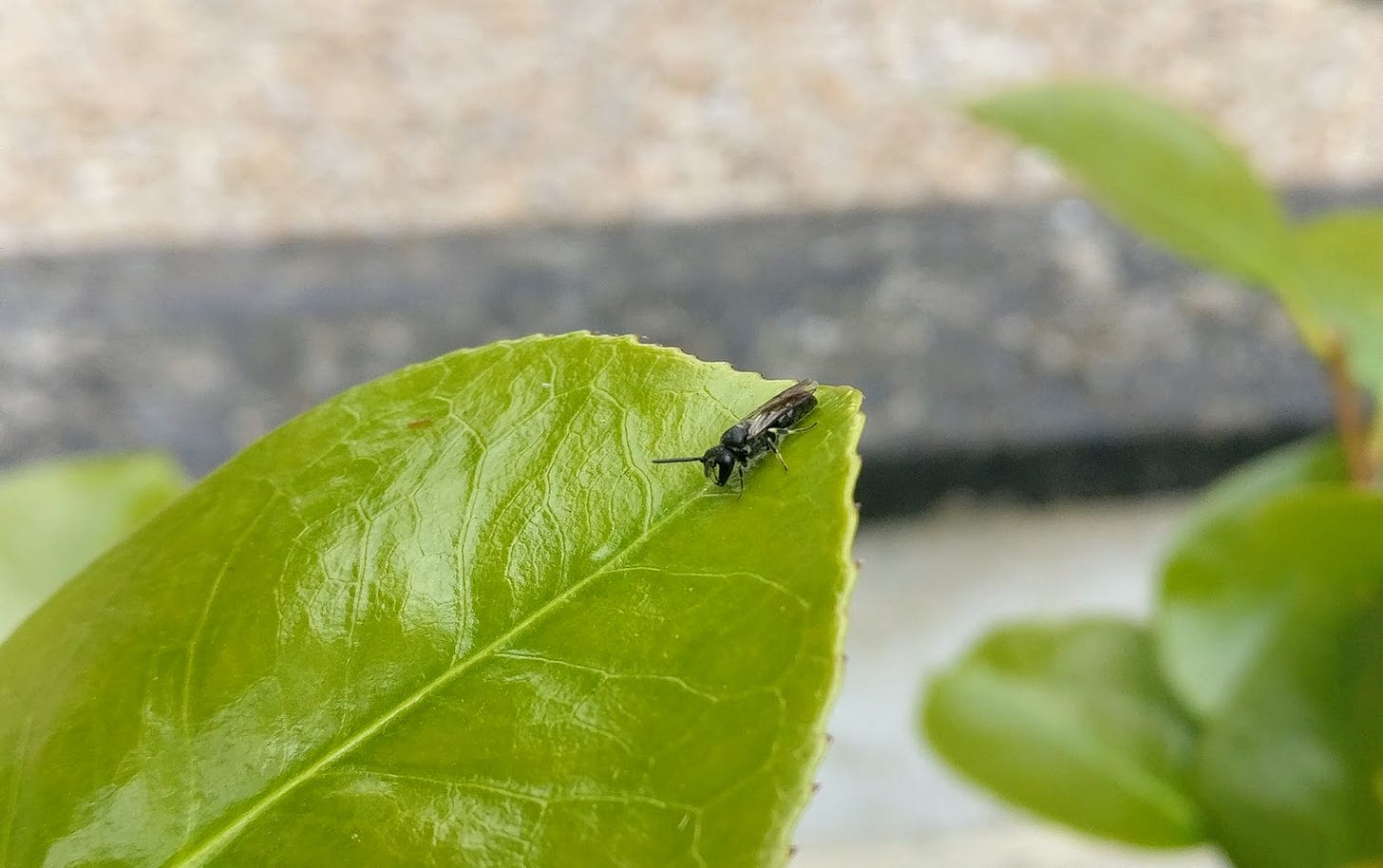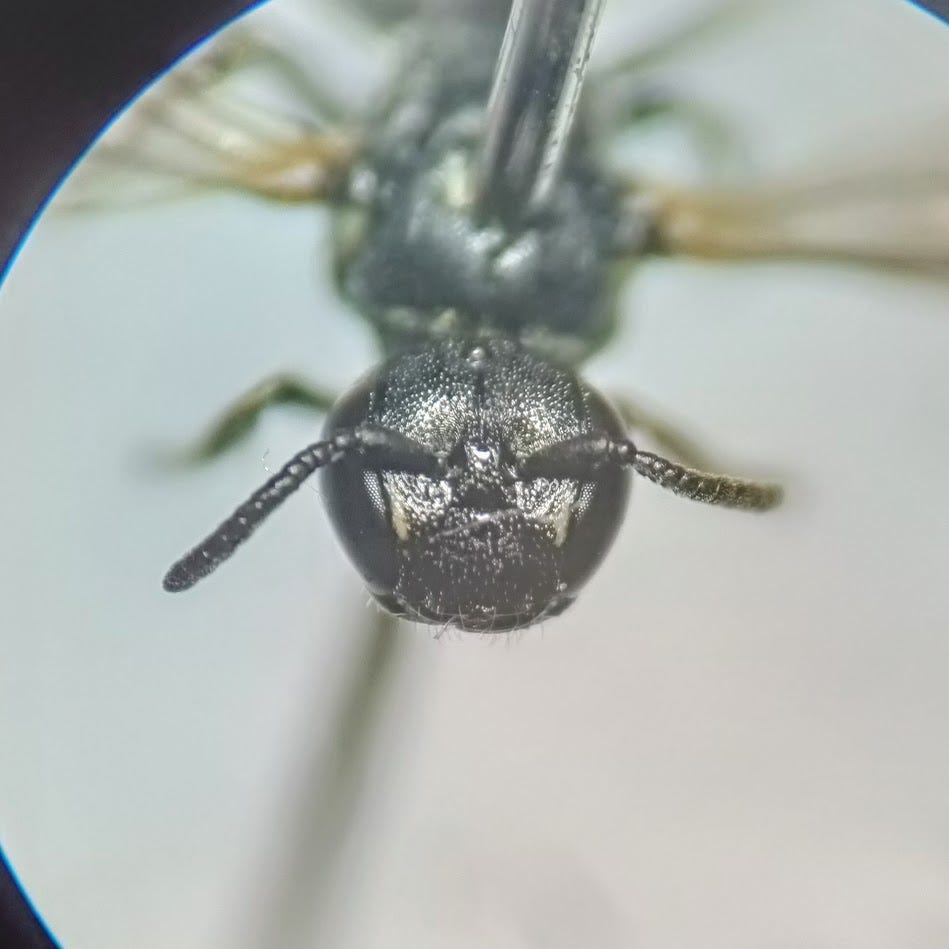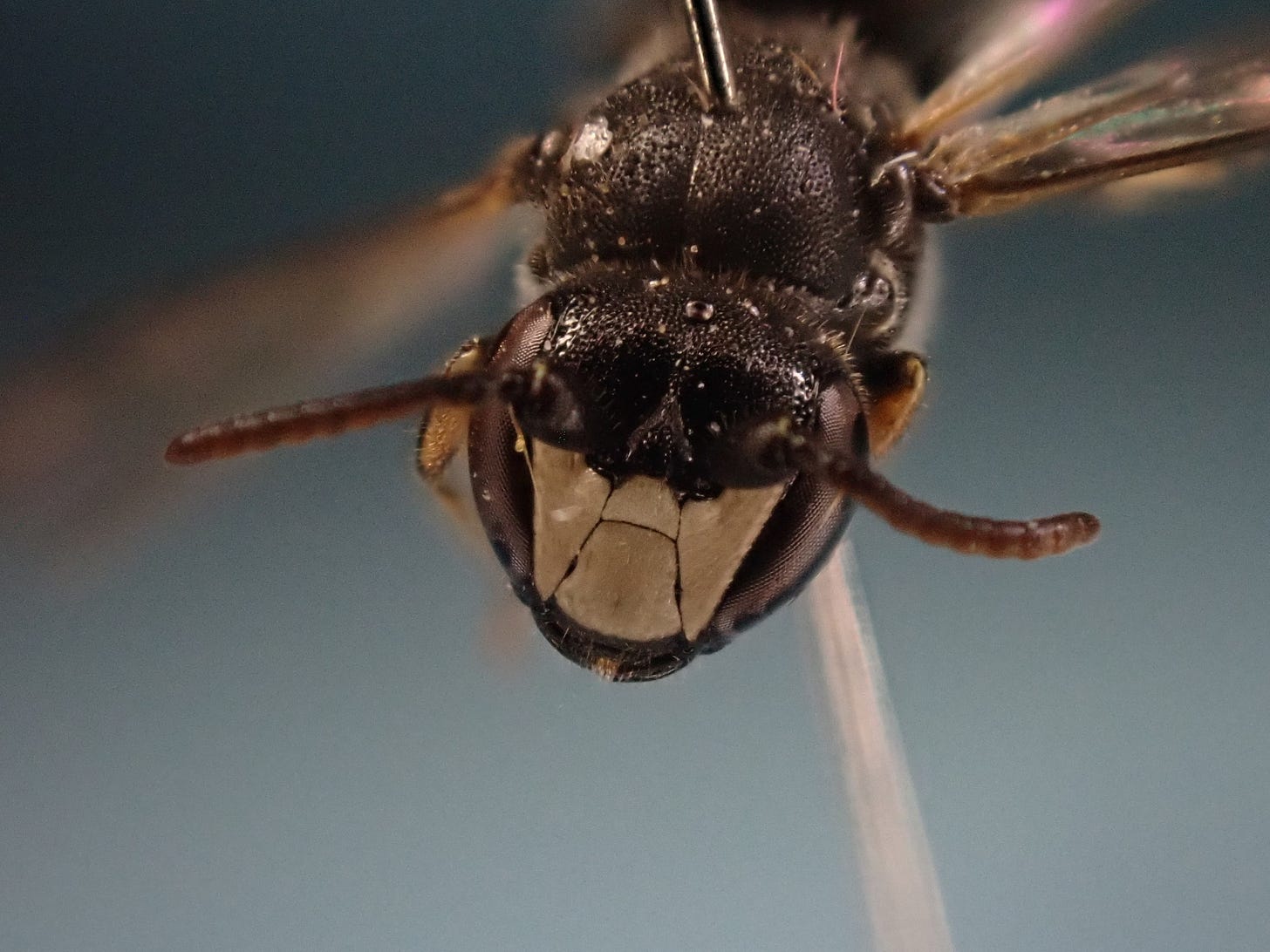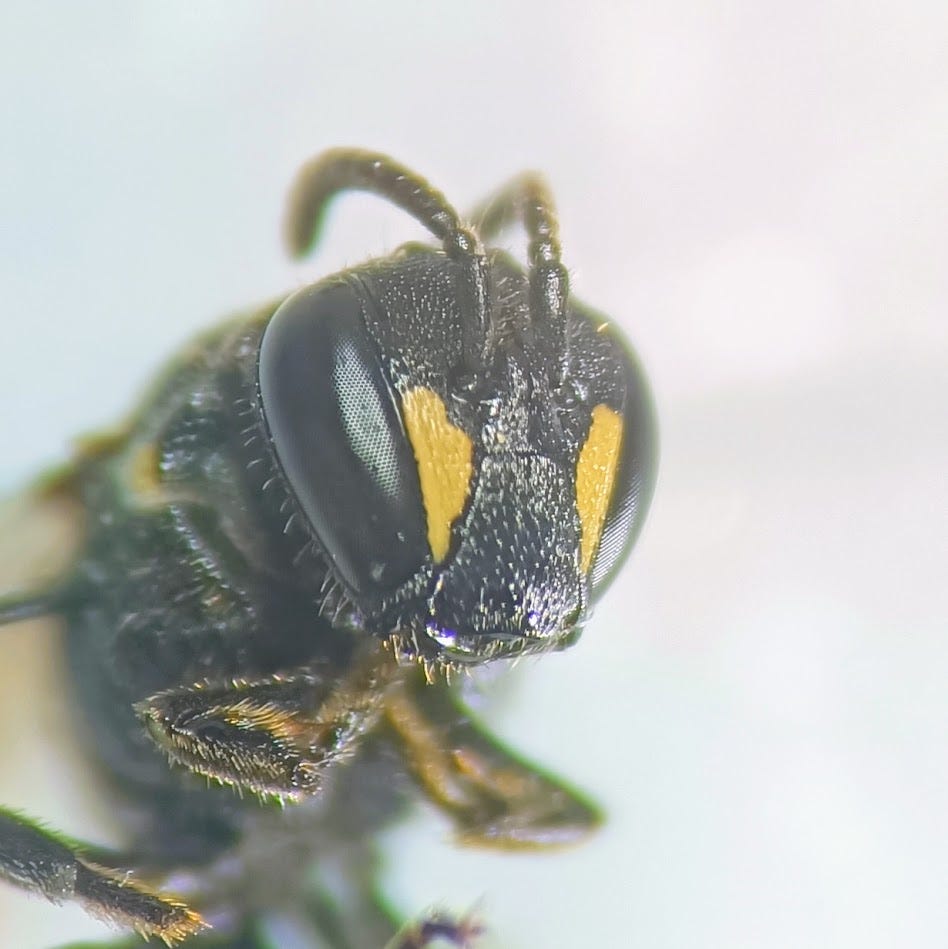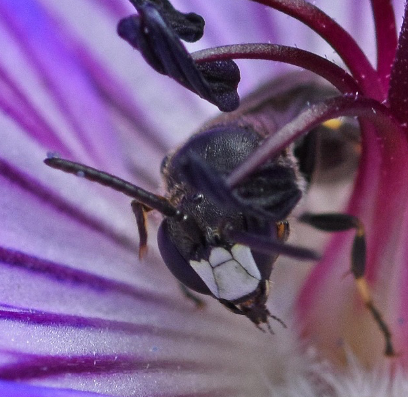Introduction
Hylaeus has its root in the Greek language and means ‘of the woods’ or ‘living in the woods’. This probably relates to the preference of these types of bees to nest in woody materials although it is often very hard to obtain evidence of the intention of those who named the genus or species of certain fauna. That said, modern life has introduced many new potential nest sites in walls and other man-made crevices.
Hylaeus, commonly called Yellow-faced Bees1, are actually a subfamily of the Colletidae (Plasterer Bees, also called Polyester Bees), and like the Colletidae, Yellow-faced Bees also line their nests with a cellophane-like material to give them structure and make them waterproof.
There are four species of Yellow-faced Bees recorded in Ireland. They are:
Hylaeus brevicornis (Short-horned Yellow-faced Bee)
Hylaeus communis (Common Yellow-faced Bee)
Hylaeus confusus (White-jawed Yellow-faced Bee)
Hylaeus hyalinatus (Hairy Yellow-faced Bee)
To be honest, you could easily mistake any of these as small flies, wasps or flying ants because of their colouring (black and yellow/white) or their size (small to very small). And they are so very inconspicuously haired such that you might easily pass them over in a bee line-up.
The Irish species range from about 4.5-6mm in length. Go ahead, make that size between your index finger and thumb to see what that means in real life. And now you see why they are so often overlooked.
One very special feature about the Irish (and most British) Yellow-faced Bees is that they do not deliberately collect pollen on the hairs of their legs or abdomen (Remember: Most of the species are very sparsely haired). Rather, they ingest both pollen and nectar into a crop and regurgitate it into the nest cells back at their nesting cavity where it can be eaten by larvae after .
Hylaeus brevicornis Nylander, 1852
EN: Short-horned Yellow-faced Bee
GA: Beach Aghaidhbhuí Ghearradharcach
A very small Hylaeus species (about 4.5-5mm), the females of this bee, as shown in the photo below, tend to have shorter antennae than you might expect from a normal bee.
The face also appears short and round. They are usually active from May through to September and populate a wide variety of habitats if suitable nesting materials are available to them.
Males also have a rounded face with the lower half almost fully covered in white/yellow (see image below).
Recorded Distribution (2003-2023)
Records of this species appear to be scare but widespread and focused on the east and south of the island.
Etymology
When naming the bee in 1852, the famous botanist and entomologist, William Nylander stated:
“Hylaeus brevicornis … sp. similis Hylaeo armillato sed differ femina antennis paulo brevioribus…”2
“Hylaeus brevicornis … species similar to Hylaeo armillato but female differs with slightly shorter antennae…”
The Latin name, brevicornis, comes from:
brevis - meaning ‘short’. This is the root of the word brevity in common use in English.
cornus - meaning ‘horn’. Think of the cornucopia, the horn of plenty.
The English translation, therefore, seems to be a direct translation of the Latin, which is not always the case with bee names. Both German and Dutch refer to it as a Short-antennaed Masked Bee.
Given that both the Latin and English names agree on this, it seemed to make sense to mirror them with the Irish version. When I was trying to get an Irish language name for each of our native bees, this was the first name I worked on with Jenny from tearma.ie and which gave me an idea as to the procedure behind the naming process. Initially I had thought of a nice colloquial name using the diminutive of Adharc (horn) – Adharcán which would have resulted in Beach Aghaidhbhuí Adharcánach. However, one step of the procedure in assigning names to species is to determine if an existing species has given precedence to the adjectival naming.
In this case, there already existed a species of butterfly called the Short-horned Baronia which had already been translated as Baróine Gearradharcach which naturally led to the new name below.
Beach Aghaidhbhuí Ghearradharcach3
Beach is the Irish for bee.
Aghaidh is the Irish for face, and b(h)uí is the colour yellow.
Gearr means ‘short’ and adharc is the Irish for a horn (zoologically speaking). The -ach at the end of the word effectively makes the word become an adjective.
Hylaeus communis Nylander, 1852
EN: Common Yellow-faced Bee
GA: Beach Aghaidhbhuí Choiteann
Slightly bigger than the Hylaeus brevicornis by about 1-1.5mm, coming in at about 6-7mm in length. The females generally have a definite triangle of yellow that sits beside the eye as can be seen below.
Some females can display greatly reduced facial spots though, whereas the males have much more yellow present on their faces, as seen below, where the yellow markings curl around the antennae insertion points.
Once you see these bees for the first time, and you do have to look as they are very small, you will start to see them everywhere. Their semi-chaotic flight patterns are very characteristic.
Recorded Distribution (2000 - 2023)
Like Hylaeus brevicornis, they are normally active from May through to September and, again like H. brevicornis, also populate a wide variety of habitats. According to Falk4, they are the most likely Hylaeus to occupy your garden bee hotel.
Etymology
The Latin communis means ‘common’, ‘ordinary’ or ‘commonplace’. The English translation reflects this directly. Other European language such as Dutch and German both refer to it as the Common Masked Bee, while Danish calls it a Garden Masked Bee and Swedish calls it a Gårdscitronbi, gårds being a reference to a farm, farmyard or courtyard.
Beach Aghaidhbhuí Choiteann
Coiteann is the accepted word for ‘common’ in the zoological context. As per the naming procedure, and as mentioned previously, there is already an Irish word for such a situation. At the time of writing, Bombus pascuorum (Common Carder Bee) already existed in the tearma.ie database as Beach Charda Choiteann.
Hylaeus confusus Nylander, 1852
EN: White-jawed Yellow-faced Bee
GA: Beach Aghaidhbhuí Ghiallbhán
Hylaeus confusus is equal in size to Hylaeus communis at about 6-7mm in length. Again, as with the previous Hylaeus species, May through to September seems to be their season. In terms of nesting, they are similar to the previous Hylaeus species. Pithy wood and flower stems and existing holes in wood and even oak galls appear to be used.
A lot of females of the Hylaeus genus require microscopic identification, the males, however, do often offer species-level identification based on the yellow patches on their face as per the photo below.
Recorded Distribution (2003-2023)
This species is fairly widespread and local across the country, including the north, which is not the case with the other Hylaeus species.
Etymology
The Latin confusus is a hard word to tie down. It means ‘mixed’, ‘joined’ or even ‘confused’. When naming the bee in 1852, “Nylander’s text does imply that [confusion], as he gives various differences from the signatus of Kirby. But there is an extra nuance in that he says there was a nomenclatural muddle with the same name being applied to two different creatures. In other words, he had to rename his signatus as confusus because the name was already in use. The first sentence translates: ‘The H. signatus of Kirby is entirely different from my species of the same name, which I have therefore had to change and call H. confusus’”.5
The English name, though, comes from a physical characteristic present only in the males. The jaws, whilst not completely white, appear to have strong white streaks in them, see photo above.
Interestingly, in both Swedish and Danish, this bee is referenced as a Meadow Bee. In Dutch it is called a Polder Masked Bee, a polder being a type of low-lying land reclaimed from the sea. German, however, describes it as a Confused Masked Bee or Unrecognised Masked Bee, again, most likely referring to the H. signatus confusion described above.
Beach Aghaidhbhuí Ghiallbhán
Giall is the Irish word for jaw.
Bán is the most commonly used Irish word for the colour white.
Hylaeus hyalinatus Smith, 1842
EN: Hairy Yellow-faced Bee
GA: Beach Aghaidhbhuí Chlúmhach
Perhaps a tiny bit smaller than Hylaeus confusus, with the females looking very similar. They do, however have a longer face, and the males have very conspicuous with the long hairs present on their face (hence the name).
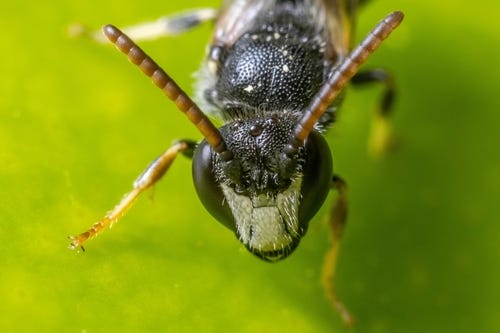
They have the same flight season as all of the other Hylaeus bees in Ireland (May to September). Unlike like its Irish relatives, though, it is happy to nest in soil, walls and previously excavated holes in wood.
Recorded Distribution (2003 - 2023)
A scarce species that seems comfortable only on the south coast. Like all the others, though, it is likely that it is under-recorded due to its diminutive size.
Etymology
Hyalinatus would seem to have its root in the Latin, meaning something glassy or glassy green. Perhaps this refers to the hairy face of the male bee, it’s hard to tell. There is no real clue to be had from other European languages unfortunately.
In giving this bee an Irish name, it was decided to stick with the physical characteristic of the male as the descriptor.
Beach Aghaidhbhuí Chlúmhach
Clúmhach is the Irish word for something which is hairy, but not necessarily related to hair on the head. It means hairy, for sure, but it also means, downy, fuzzy, and fluffy. A downy fledgling bird could be described as clúmhach. The Irish poet Michael Hartnett referred to a nest full of fledglings in his poem An Muince Dreolíní (A Necklace of Wrens)6, which was further immortalised by The Gloaming in their debut album7, although his clúmhtha is, I believe, a colloquial term meaning the same thing.
Closing
Once again, I do hope you enjoyed this long-form exploration of one of Ireland’s most diminutive and beautiful bee genera.
Please share with anyone who you think might have an interest.
Brian
Today, 7th July 2023, I just had an interesting Twitter discussion with Ian Beavis (Research Curator at The Amelia Museum in Tunbridge Wells) and Steven Falk (Author of Field Guide to the Bees of Great Britain and Ireland) about the use of Yellow-face Bees versus Yellow-faced Bees. See here: https://twitter.com/BeesOfIreland/status/1677227095515070464
For me, it seems better to use Yellow-faced Bees so I will use that phrase.
Nylander, W. 1852. Supplementum adnotationum in expositionem Apum borealium. – Not. Sällsk. F. & Fl. Fenn. Förhandl. 2: 93-107.
https://www.tearma.ie/q/hylaeus%20brevicornis/
Falk, S 2016, Field Guide to the Bees of Britain and Ireland, Bloomsbury Wildlife, UK
From correspondence with Dr. Ian Beavis, Research Curator at The Amelia, Tunbridge Wells
http://bit.ly/clumhtha




